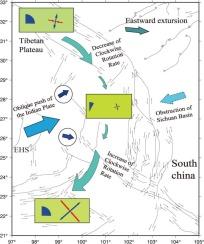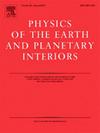Data-driven crustal deformation model in southeastern Tibetan Plateau using unsupervised machine learning techniques for GNSS observations
IF 1.9
3区 地球科学
Q2 GEOCHEMISTRY & GEOPHYSICS
引用次数: 0
Abstract
The Southeastern Tibetan Plateau (STP) is a crucial place in understanding how stress is transmitted between the India-Eurasia collision belt and the surrounding blocks. It was accustomed to applying block models to study its deformation characteristics, which can hide or ignore some information due to the artificial division of the blocks. Therefore, we use an unsupervised machine learning method to analyze the tectonic deformation of the southeastern Tibetan Plateau without any prior information constraints. Firstly, we conducted K-means clustering analysis on GNSS velocity and identified the best cluster model using gap analysis, and we used Hierarchical Agglomerative Clustering to assess the reliability of this optimal cluster. Next, we used the method of spherical strain to obtain the translation rate, rotation rate, principal strain, surface strain, and second strain invariants for each cluster. After conducting cluster analysis and strain estimation, our results indicate that the oblique convergence of the Indian plate at the eastern Himalaya tectonic syntaxis is significantly involved in the deformation of the southeastern Tibetan Plateau. On the one hand, it slows down the crustal material migration caused by the gravitational potential energy in the Tibetan Plateau, resulting in the decrease of the rotation rate from the plateau to the middle of the STP. On the other hand, it encourages the lateral expansion of the STP, increasing the rotation rate from the central part of the STP to the Nantinghe fault and Menglian fault. This model has also confirmed the eastward growth mechanism of the Tibetan Plateau. It suggests that the oblique convergence of the Indian plate along the Eastern Himalayan tectonic syntaxis may be essential for the formation of regional tectonic deformation that has been ongoing since 20 million years ago.

通常采用块模型来研究其变形特征,由于块的人为划分,可能会隐藏或忽略某些信息。首先,对GNSS航速进行K-means聚类分析,利用gap分析法确定最佳聚类模型,并采用分层聚类方法对该聚类的可靠性进行评估。接下来,我们使用球应变法获得了每个簇的平移速率、旋转速率、主应变、表面应变和第二应变不变量。另一方面,它促进STP的横向扩张,增加了STP中部向南汀河断裂和孟连断裂的旋转速率。这表明印度板块沿东喜马拉雅构造合结的斜辐合可能是2000万年前区域构造变形形成的必要条件。
本文章由计算机程序翻译,如有差异,请以英文原文为准。
求助全文
约1分钟内获得全文
求助全文
来源期刊

Physics of the Earth and Planetary Interiors
地学天文-地球化学与地球物理
CiteScore
5.00
自引率
4.30%
发文量
78
审稿时长
18.5 weeks
期刊介绍:
Launched in 1968 to fill the need for an international journal in the field of planetary physics, geodesy and geophysics, Physics of the Earth and Planetary Interiors has now grown to become important reading matter for all geophysicists. It is the only journal to be entirely devoted to the physical and chemical processes of planetary interiors.
Original research papers, review articles, short communications and book reviews are all published on a regular basis; and from time to time special issues of the journal are devoted to the publication of the proceedings of symposia and congresses which the editors feel will be of particular interest to the reader.
 求助内容:
求助内容: 应助结果提醒方式:
应助结果提醒方式:


